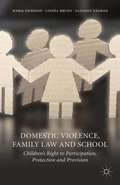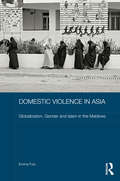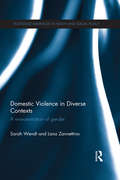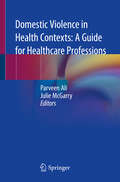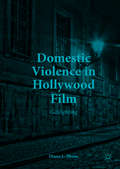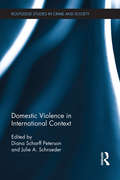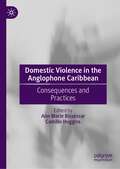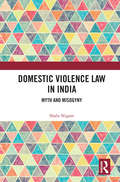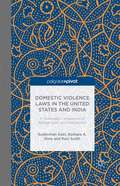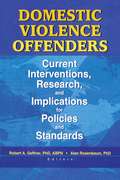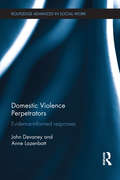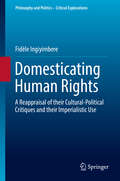- Table View
- List View
Domestic Violence, Family Law and School: Children's Right to Participation, Protection and Provision
by M. Eriksson L. Bruno E. NäsmanDomestic Violence, Family Law and School discusses the ways in which family law disputes in cases of domestic violence can impact on children's lives at pre-school and school. In drawing on new research, the book establishes a new framework for understanding how welfare systems tackle domestic violence.
Domestic Violence in Asia: Globalization, Gender and Islam in the Maldives (ASAA Women in Asia Series)
by Emma FuluThis book explores changing patterns of domestic violence in Asia. Based on extensive original research in the Maldives, it argues that forces of globalisation, consumerism, Islamism and democratisation are changing the nature of domestic relations, with shifting ideas surrounding gender and Islam being particularly significant. The book points out that domestic violence has been relatively low in the Maldives in comparison with other Asian countries, as a result of, the book argues, a history of relatively equal gender relations, an ideology of masculinity that is associated with calmness and rationality where violence is not considered an acceptable means of dealing with problems, and flexible marriage and divorce practices. The book shows how these factors are being undermined by new ideas which emphasise the need for wifely obedience, increasing gender inequality and the right of husbands to be coercive.
Domestic Violence in Asia: Globalization, Gender and Islam in the Maldives (ASAA Women in Asia Series)
by Emma FuluThis book explores changing patterns of domestic violence in Asia. Based on extensive original research in the Maldives, it argues that forces of globalisation, consumerism, Islamism and democratisation are changing the nature of domestic relations, with shifting ideas surrounding gender and Islam being particularly significant. The book points out that domestic violence has been relatively low in the Maldives in comparison with other Asian countries, as a result of, the book argues, a history of relatively equal gender relations, an ideology of masculinity that is associated with calmness and rationality where violence is not considered an acceptable means of dealing with problems, and flexible marriage and divorce practices. The book shows how these factors are being undermined by new ideas which emphasise the need for wifely obedience, increasing gender inequality and the right of husbands to be coercive.
Domestic Violence in Diverse Contexts: A Re-examination of Gender
by Sarah Wendt Lana ZannettinoOverwhelmingly, it is women who are the victims of domestic violence and this book puts women’s experiences of domestic violence at its centre, whilst acknowledging their many diverse and complex identities. Concentrating on the various forms of domestic abuse and its occurrence and manifestations within different contexts, it argues that gender is centrally implicated in the unique factors that shape violence across all these areas. Individual chapters outline the experiences of: Mothers Older women Women with religious affiliations Refugee women Rural women Aboriginal women Women in same-sex relationships Women with intellectual disabilities. Exploring how domestic violence across varying contexts impacts on different women’s experiences and understandings of abuse, this innovative work draws on post-structural feminist theory and how these ideas view, and potentially allow, gendered explanations of domestic violence. Domestic Violence in Diverse Contexts is suitable for academics and researchers interested in issues around violence and gender.
Domestic Violence in Diverse Contexts: A Re-examination of Gender
by Sarah Wendt Lana ZannettinoOverwhelmingly, it is women who are the victims of domestic violence and this book puts women’s experiences of domestic violence at its centre, whilst acknowledging their many diverse and complex identities. Concentrating on the various forms of domestic abuse and its occurrence and manifestations within different contexts, it argues that gender is centrally implicated in the unique factors that shape violence across all these areas. Individual chapters outline the experiences of: Mothers Older women Women with religious affiliations Refugee women Rural women Aboriginal women Women in same-sex relationships Women with intellectual disabilities. Exploring how domestic violence across varying contexts impacts on different women’s experiences and understandings of abuse, this innovative work draws on post-structural feminist theory and how these ideas view, and potentially allow, gendered explanations of domestic violence. Domestic Violence in Diverse Contexts is suitable for academics and researchers interested in issues around violence and gender.
Domestic Violence in Health Contexts: A Guide for Healthcare Professions
by Parveen Ali Julie McGarryThis book is taking a broad health focused approach towards Domestic Violence and Abuse (DVA). It is now well established that DVA exerts a significant and detrimental impact on the health and wellbeing of those who experience abuse. Universally healthcare professionals encounter individuals and families where DVA is or has taken place. This book is beneficial to a range of health care professionals through an exploration of theories and classifications of DVA, consideration of DVA in different contexts and consideration of the core issues surrounding working with individuals and families where DVAhas been identified. It provides a much needed evidence based addition to the existing texts in this field in terms of the inclusion of real life scenarios, reflective exercises and pointers for further practice development. This book is a key point of reference for professionals working within a broad range of health care environments.
Domestic Violence in Hollywood Film: Gaslighting (PDF)
by Diane L. ShoosThis is the first book to critically examine Hollywood films that focus on male partner violence against women. These films include Gaslight, Sleeping with the Enemy, What’s Love Got to Do with It, Dolores Claiborne, Enough, and Safe Haven. Shaped by the contexts of postfeminism, domestic abuse post-awareness, and familiar genre conventions, these films engage in ideological “gaslighting” that reaffirms our preconceived ideas about men as abusers, women as victims, and the racial and class politics of domestic violence. While the films purport to condemn abuse and empower abused women, this study proposes that they tacitly reinforce the very attitudes that we believe we no longer tolerate. Shoos argues that films like these limit not only popular understanding but also social and institutional interventions.
Domestic Violence in International Context (Routledge Studies in Crime and Society)
by Diana Scharff Peterson and Julie A. SchroederDomestic violence does not discriminate and is prevalent throughout the word regardless of race, age or socio-economic status. Why, then, do reactions and response differ so widely throughout the world? While some countries work diligently to address the matter through prevention and training, others take a ‘hands-off’ approach in their response. This book is one of the first to investigate domestic violence on a global scale and provides best practices gleaned from various countries around the world to paint a detailed picture of how police response to domestic violence is currently being conducted and provide training bodies with up-to-date information to enhance current curricula. Domestic Violence in International Context brings together expert scholars native to twelve different countries to examine the history and scope of domestic violence and how it is being addressed, repressed or ignored in their thirteen respective countries. Their specialised knowledge and unique data come together to create a series of snapshots that will guide nations, societies and communities worldwide in formulating effective strategies to prevent, intervene and combat this epidemic, and examine partnerships and programmes already in place. This book is essential reading for practitioners, policy makers, and human rights organisations, as well as students and scholars of criminology, social work, sociology and law.
Domestic Violence in International Context (Routledge Studies in Crime and Society)
by Diana Scharff Peterson Julie A. SchroederDomestic violence does not discriminate and is prevalent throughout the word regardless of race, age or socio-economic status. Why, then, do reactions and response differ so widely throughout the world? While some countries work diligently to address the matter through prevention and training, others take a ‘hands-off’ approach in their response. This book is one of the first to investigate domestic violence on a global scale and provides best practices gleaned from various countries around the world to paint a detailed picture of how police response to domestic violence is currently being conducted and provide training bodies with up-to-date information to enhance current curricula. Domestic Violence in International Context brings together expert scholars native to twelve different countries to examine the history and scope of domestic violence and how it is being addressed, repressed or ignored in their thirteen respective countries. Their specialised knowledge and unique data come together to create a series of snapshots that will guide nations, societies and communities worldwide in formulating effective strategies to prevent, intervene and combat this epidemic, and examine partnerships and programmes already in place. This book is essential reading for practitioners, policy makers, and human rights organisations, as well as students and scholars of criminology, social work, sociology and law.
Domestic Violence in the Anglophone Caribbean: Consequences and Practices
by Ann Marie Bissessar Camille HugginsDomestic violence continues to be a social problem that is rarely understood or discussed in many parts of the world. The same holds true in the Anglophone Caribbean. The Caribbean context is unique as it was birthed out of colonization, which was violent and brutal for those who were forced to migrate from another country as enslaved labor, as well as for those who were conquered out of their lands. Most Caribbean islands’ societies were created and developed by slaves, colonizers, and indentured servants. This history has left an indelible scar on all involved, which is exemplified by the antagonistic way people interact, whether it is between races, ethnicities, religions, or gender. Traditionally, domestic relationships and causal factors for domestic violence has been investigated from a myriad of perspectives including the ethnic lineage of the participants. However, in the Caribbean due to its historic origins, domestic violence should also be examined through the lens of its colonial past. This book examines the consequences of allowing domestic violence to perpetuate in the region. It then looks at some of practices used to provide support and find justice for victims and perpetrators in a Caribbean cultural context.
Domestic Violence Law in India: Myth and Misogyny
by Shalu NigamThis book examines the prevailing legal discourse surrounding domestic violence law in India. It investigates the myths, patriarchal stereotypes, and misconceptions that undermine the process of justice and dilute legal provisions to the detriment of survivors. The volume: Develops arguments based on legal case studies and draws extensively on knowledge from various fields of study, as well as the experience of women survivors. Examines fallacies within the legal framework through a study of strategic lawsuits against public participation suits within the Indian context. Proposes measures for a fair and more gender inclusive legal system that focuses on facilitating access to justice. Suggests that emphasis be laid on establishing the rule of law and eliminating the culture of violence. A key text on gender and law in India, this book will be indispensable to scholars and researchers of socio-legal studies, law, gender, human rights, women’s studies, social science, political science, and feminist jurisprudence in South Asia. It will also be of interest to NGOs, activists, and lawyers.
Domestic Violence Law in India: Myth and Misogyny
by Shalu NigamThis book examines the prevailing legal discourse surrounding domestic violence law in India. It investigates the myths, patriarchal stereotypes, and misconceptions that undermine the process of justice and dilute legal provisions to the detriment of survivors. The volume: Develops arguments based on legal case studies and draws extensively on knowledge from various fields of study, as well as the experience of women survivors. Examines fallacies within the legal framework through a study of strategic lawsuits against public participation suits within the Indian context. Proposes measures for a fair and more gender inclusive legal system that focuses on facilitating access to justice. Suggests that emphasis be laid on establishing the rule of law and eliminating the culture of violence. A key text on gender and law in India, this book will be indispensable to scholars and researchers of socio-legal studies, law, gender, human rights, women’s studies, social science, political science, and feminist jurisprudence in South Asia. It will also be of interest to NGOs, activists, and lawyers.
Domestic Violence Laws in the United States and India: A Systematic Comparison of Backgrounds and Implications
by S. Goel B. Sims R. SodhiDomestic Violence Laws in the United States and India is a comparative study of the domestic violence laws in India and the United States, seeking to illuminate the critical issues of intimate partner violence through the lenses of these two societies.
Domestic Violence Offenders: Current Interventions, Research, and Implications for Policies and Standards
by Alan RosenbaumWomen’s shelters and safe houses were a good first step, but they only address part of the problem. Learn what else must be done to address the problem of domestic violence! Domestic Violence Offenders presents recent research, current interventions, and legal standards for people arrested for domestic violence. It also addresses the controversies that have arisen in the wake of the mandatory standards for batterer interventions that have been established by various jurisdictions, examining the type of treatment modality and content permitted by various jurisdictions, the duration of treatment, and the relationship of the various standards to actual research. This essential book also provides suggestions for a more inclusive, less rigid process for creating standards and policies for use with this population. Handy tables and charts make the information easily accessible. From the editors: “The initial societal response to intimate partner violence was the development of the shelter movement for battered women. Women&’s shelters and/or safe houses developed in almost all major population areas throughout the United States and abroad. The goals were to provide a safe environment for abused women and their children, to offer advocacy, counseling, and medical services, and to empower women to leave their abusers. While shelters continue to serve these and other critical needs and are an essential part of the service delivery system for battered women, they address only part of the problem. Left untreated, batterers often will continue to abuse their partners who leave shelters and return to the relationship. If their partners leave the relationship, the batterers may find new victims to abuse. The response to this harsh reality was the development of batterer intervention programs.” Domestic Violence Offenders provides you with informed discussions of: the implications of research and policies for those providing interventions why it is premature for states to establish certain rigid standards for batterer programs, and how some of the current standards may produce more harm than good the history of batterer intervention programs completion and recidivism among court- and self-referred batterers the Alternatives to Violence program and the experiences and perceptions of its founder common aspects of various intervention programs—confidentiality, group structure and length, partner contacts, leadership configuration, and program goals topics addressed by most programs—power and control, anger management, substance abuse, stress reduction, parenting, communication, and more the controversial and often misunderstood issue of female partner aggression and violence the Stages of Change approach to domestic violence treatment lethality assessment and safety planning for partners of batterers the advantages of conjoint therapy for certain types of cases the Illinois Protocol for batterer programs outcome research on programs for batterers and a great deal more!
Domestic Violence Offenders: Current Interventions, Research, and Implications for Policies and Standards
by Alan RosenbaumWomen’s shelters and safe houses were a good first step, but they only address part of the problem. Learn what else must be done to address the problem of domestic violence! Domestic Violence Offenders presents recent research, current interventions, and legal standards for people arrested for domestic violence. It also addresses the controversies that have arisen in the wake of the mandatory standards for batterer interventions that have been established by various jurisdictions, examining the type of treatment modality and content permitted by various jurisdictions, the duration of treatment, and the relationship of the various standards to actual research. This essential book also provides suggestions for a more inclusive, less rigid process for creating standards and policies for use with this population. Handy tables and charts make the information easily accessible. From the editors: “The initial societal response to intimate partner violence was the development of the shelter movement for battered women. Women&’s shelters and/or safe houses developed in almost all major population areas throughout the United States and abroad. The goals were to provide a safe environment for abused women and their children, to offer advocacy, counseling, and medical services, and to empower women to leave their abusers. While shelters continue to serve these and other critical needs and are an essential part of the service delivery system for battered women, they address only part of the problem. Left untreated, batterers often will continue to abuse their partners who leave shelters and return to the relationship. If their partners leave the relationship, the batterers may find new victims to abuse. The response to this harsh reality was the development of batterer intervention programs.” Domestic Violence Offenders provides you with informed discussions of: the implications of research and policies for those providing interventions why it is premature for states to establish certain rigid standards for batterer programs, and how some of the current standards may produce more harm than good the history of batterer intervention programs completion and recidivism among court- and self-referred batterers the Alternatives to Violence program and the experiences and perceptions of its founder common aspects of various intervention programs—confidentiality, group structure and length, partner contacts, leadership configuration, and program goals topics addressed by most programs—power and control, anger management, substance abuse, stress reduction, parenting, communication, and more the controversial and often misunderstood issue of female partner aggression and violence the Stages of Change approach to domestic violence treatment lethality assessment and safety planning for partners of batterers the advantages of conjoint therapy for certain types of cases the Illinois Protocol for batterer programs outcome research on programs for batterers and a great deal more!
Domestic Violence Perpetrators: Evidence-Informed Responses (Routledge Advances in Social Work)
by Anne Lazenbatt John DevaneyDomestic violence is a serious, widespread public, social and health problem that affects the lives of many women, children and men. There is also evidence to suggest it has one of the highest rates of recidivism. This comprehensive book provides an overview of what the research tells us about the perpetrators of domestic violence and what works, and what doesn’t, in promoting positive change. Collecting together the most up-to-date evidence from the international literature and bringing psychological, sociological, gendered and socio-political theoretical perspectives to bear on the issue, the authors explore: - what domestic violence is, why it happens and how it can be measured - who the perpetrators of domestic violence are, including discussion of non-stereotypical patterns such as male victims, female perpetrators, couples where the abuse is mutual, and couples with abusive relationships who want the abuse to end but the relationship to be sustained - strategies for engaging perpetrators in interventions and for promoting behaviour change - evidence-informed interventions, programmes and policies for working with perpetrators - where robust evidence is lacking and more research needs to be undertaken. Domestic violence is a significant problem for those individuals and families whose life is affected by this issue, the social, health and criminal justice agencies that respond to it, and wider society which must bear the costs and its devastating effects. This volume is an important reference for all those researching and working with the victims, survivors and perpetrators of domestic violence, including academics and students from fields such as social work, sociology, criminology, psychology and social policy.
Domestic Violence Perpetrators: Evidence-Informed Responses (Routledge Advances in Social Work)
by Anne Lazenbatt John DevaneyDomestic violence is a serious, widespread public, social and health problem that affects the lives of many women, children and men. There is also evidence to suggest it has one of the highest rates of recidivism. This comprehensive book provides an overview of what the research tells us about the perpetrators of domestic violence and what works, and what doesn’t, in promoting positive change. Collecting together the most up-to-date evidence from the international literature and bringing psychological, sociological, gendered and socio-political theoretical perspectives to bear on the issue, the authors explore: - what domestic violence is, why it happens and how it can be measured - who the perpetrators of domestic violence are, including discussion of non-stereotypical patterns such as male victims, female perpetrators, couples where the abuse is mutual, and couples with abusive relationships who want the abuse to end but the relationship to be sustained - strategies for engaging perpetrators in interventions and for promoting behaviour change - evidence-informed interventions, programmes and policies for working with perpetrators - where robust evidence is lacking and more research needs to be undertaken. Domestic violence is a significant problem for those individuals and families whose life is affected by this issue, the social, health and criminal justice agencies that respond to it, and wider society which must bear the costs and its devastating effects. This volume is an important reference for all those researching and working with the victims, survivors and perpetrators of domestic violence, including academics and students from fields such as social work, sociology, criminology, psychology and social policy.
Domesticating Empire: Egyptian Landscapes in Pompeian Gardens
by Caitlín Eilís BarrettDomesticating Empire is the first contextually-oriented monograph on Egyptian imagery in Roman households. Caitlín Barrett draws on case studies from Flavian Pompeii to investigate the close association between representations of Egypt and a particular type of Roman household space: the domestic garden. Through paintings and mosaics portraying the Nile, canals that turned the garden itself into a miniature "Nilescape," and statuary depicting Egyptian themes, many gardens in Pompeii offered ancient visitors evocations of a Roman vision of Egypt. Simultaneously faraway and familiar, these imagined landscapes made the unfathomable breadth of empire compatible with the familiarity of home. In contrast to older interpretations that connect Roman "Aegyptiaca" to the worship of Egyptian gods or the problematic concept of "Egyptomania," a contextual analysis of these garden assemblages suggests new possibilities for meaning. In Pompeian houses, Egyptian and Egyptian-looking objects and images interacted with their settings to construct complex entanglements of "foreign" and "familiar," "self" and "other." Representations of Egyptian landscapes in domestic gardens enabled individuals to present themselves as sophisticated citizens of empire. Yet at the same time, household material culture also exerted an agency of its own: domesticizing, familiarizing, and "Romanizing" once-foreign images and objects. That which was once imagined as alien and potentially dangerous was now part of the domus itself, increasingly incorporated into cultural constructions of what it meant to be "Roman." Featuring brilliant illustrations in both color and black and white, Domesticating Empire reveals the importance of material culture in transforming household space into a microcosm of empire.
Domesticating Empire: Egyptian Landscapes in Pompeian Gardens
by Caitlín Eilís BarrettDomesticating Empire is the first contextually-oriented monograph on Egyptian imagery in Roman households. Caitlín Barrett draws on case studies from Flavian Pompeii to investigate the close association between representations of Egypt and a particular type of Roman household space: the domestic garden. Through paintings and mosaics portraying the Nile, canals that turned the garden itself into a miniature "Nilescape," and statuary depicting Egyptian themes, many gardens in Pompeii offered ancient visitors evocations of a Roman vision of Egypt. Simultaneously faraway and familiar, these imagined landscapes made the unfathomable breadth of empire compatible with the familiarity of home. In contrast to older interpretations that connect Roman "Aegyptiaca" to the worship of Egyptian gods or the problematic concept of "Egyptomania," a contextual analysis of these garden assemblages suggests new possibilities for meaning. In Pompeian houses, Egyptian and Egyptian-looking objects and images interacted with their settings to construct complex entanglements of "foreign" and "familiar," "self" and "other." Representations of Egyptian landscapes in domestic gardens enabled individuals to present themselves as sophisticated citizens of empire. Yet at the same time, household material culture also exerted an agency of its own: domesticizing, familiarizing, and "Romanizing" once-foreign images and objects. That which was once imagined as alien and potentially dangerous was now part of the domus itself, increasingly incorporated into cultural constructions of what it meant to be "Roman." Featuring brilliant illustrations in both color and black and white, Domesticating Empire reveals the importance of material culture in transforming household space into a microcosm of empire.
Domesticating Human Rights: A Reappraisal of their Cultural-Political Critiques and their Imperialistic Use (Philosophy and Politics - Critical Explorations #4)
by Fidèle IngiyimbereThis book develops a philosophical conception of human rights that responds satisfactorily to the challenges raised by cultural and political critics of human rights, who contend that the contemporary human rights movement is promoting an imperialist ideology, and that the humanitarian intervention for protecting human rights is a neo-colonialism. These claims affect the normativity and effectiveness of human rights; that is why they have to be taken seriously. At the same time, the same philosophical account dismisses the imperialist crusaders who support the imperialistic use of human rights by the West to advance liberal culture. Thus, after elaborating and exposing these criticisms, the book confronts them to the human rights theories of John Rawls and Jürgen Habermas, in order to see whether they can be addressed. Unfortunately, they are not. Therefore, having shown that these two philosophical accounts of human rights do not respond convincingly to those the postcolonial challenges, the book provides an alternative conception that draws the understanding of human rights from local practices. It is a multilayer conception which is not centered on state, but rather integrates it in a larger web of actors involved in shaping the practice and meaning of human rights. Confronted to the challenges, this new conception offers a promising way for addressing them satisfactorily, and it even sheds new light to the classical questions of universality of human rights, as well as the tension between universalism and relativism.
Domesticating Neo-Liberalism: Spaces of Economic Practice and Social Reproduction in Post-Socialist Cities (Rgs-ibg Book Ser. #54)
by Alison Stenning Adrian Smith Alena Rochovská Dariusz ŚwiątekBased on in-depth research in Poland and Slovakia, Domesticating Neo-Liberalism addresses how we understand the processes of neo-liberalization in post-socialist cities. Builds upon a vast amount of new research data Examines how households try to sustain their livelihoods at particularly dramatic and difficult times of urban transformation Provides a major contribution to how we theorize the geographies of neo-liberalism Offers a conclusion which informs discussions of social policy within European Union enlargement
Domesticating Neo-Liberalism: Spaces of Economic Practice and Social Reproduction in Post-Socialist Cities (RGS-IBG Book Series #54)
by Alison Stenning Adrian Smith Alena Rochovská Dariusz ŚwiątekBased on in-depth research in Poland and Slovakia, Domesticating Neo-Liberalism addresses how we understand the processes of neo-liberalization in post-socialist cities. Builds upon a vast amount of new research data Examines how households try to sustain their livelihoods at particularly dramatic and difficult times of urban transformation Provides a major contribution to how we theorize the geographies of neo-liberalism Offers a conclusion which informs discussions of social policy within European Union enlargement
Domesticating the Airwaves: Broadcasting, Domesticity and Femininity
by Maggie AndrewsUsing case studies and analytical overviews this book explores the relationship between broadcasting and the intimate domestic sphere into which it is broadcast. It focuses on the period from the 1920s, when broadcasting was established in the UK, to the present day when both domesticity and broadcasting have become areas of anxiety and contestation. The entry of the 'wireless', and later television, into the home changed men and women's experience of domesticity, offering education and reducing isolation. But broadcasting did not merely change domestic leisure patterns, it actively intervened in constructing domesticity. The supposedly natural relationship between femininity and domesticity has structured the nature of broadcasting, and also the discourses which have emerged concerning the consumption of broadcast media. Contemporary broadcasting continues to be obsessed by domesticity, both in an idealised sense as well as portraying the domestic world as one of turmoil and crisis. This volume demonstrates that the relationship between broadcasting and domesticity is a key, and often neglected, feature of the cultural history of Britain in the last 100 years.
Domesticating the Airwaves: Broadcasting, Domesticity and Femininity
by Maggie AndrewsUsing case studies and analytical overviews this book explores the relationship between broadcasting and the intimate domestic sphere into which it is broadcast. It focuses on the period from the 1920s, when broadcasting was established in the UK, to the present day when both domesticity and broadcasting have become areas of anxiety and contestation. The entry of the 'wireless', and later television, into the home changed men and women's experience of domesticity, offering education and reducing isolation. But broadcasting did not merely change domestic leisure patterns, it actively intervened in constructing domesticity. The supposedly natural relationship between femininity and domesticity has structured the nature of broadcasting, and also the discourses which have emerged concerning the consumption of broadcast media. Contemporary broadcasting continues to be obsessed by domesticity, both in an idealised sense as well as portraying the domestic world as one of turmoil and crisis. This volume demonstrates that the relationship between broadcasting and domesticity is a key, and often neglected, feature of the cultural history of Britain in the last 100 years.
Domesticating Youth: Youth Bulges and their Socio-political Implications in Tajikistan (Integration and Conflict Studies #8)
by Sophie RocheMost of the Muslim societies of the world have entered a demographic transition from high to low fertility, and this process is accompanied by an increase in youth vis-à-vis other age groups. Political scientists and historians have debated whether such a “youth bulge” increases the potential for conflict or whether it represents a chance to accumulate wealth and push forward social and technological developments. This book introduces the discussion about youth bulge into social anthropology using Tajikistan, a post-Soviet country that experienced civil war in the 1990s, which is in the middle of such a demographic transition. Sophie Roche develops a social anthropological approach to analyze demographic and political dynamics, and suggests a new way of thinking about social change in youth bulge societies.
